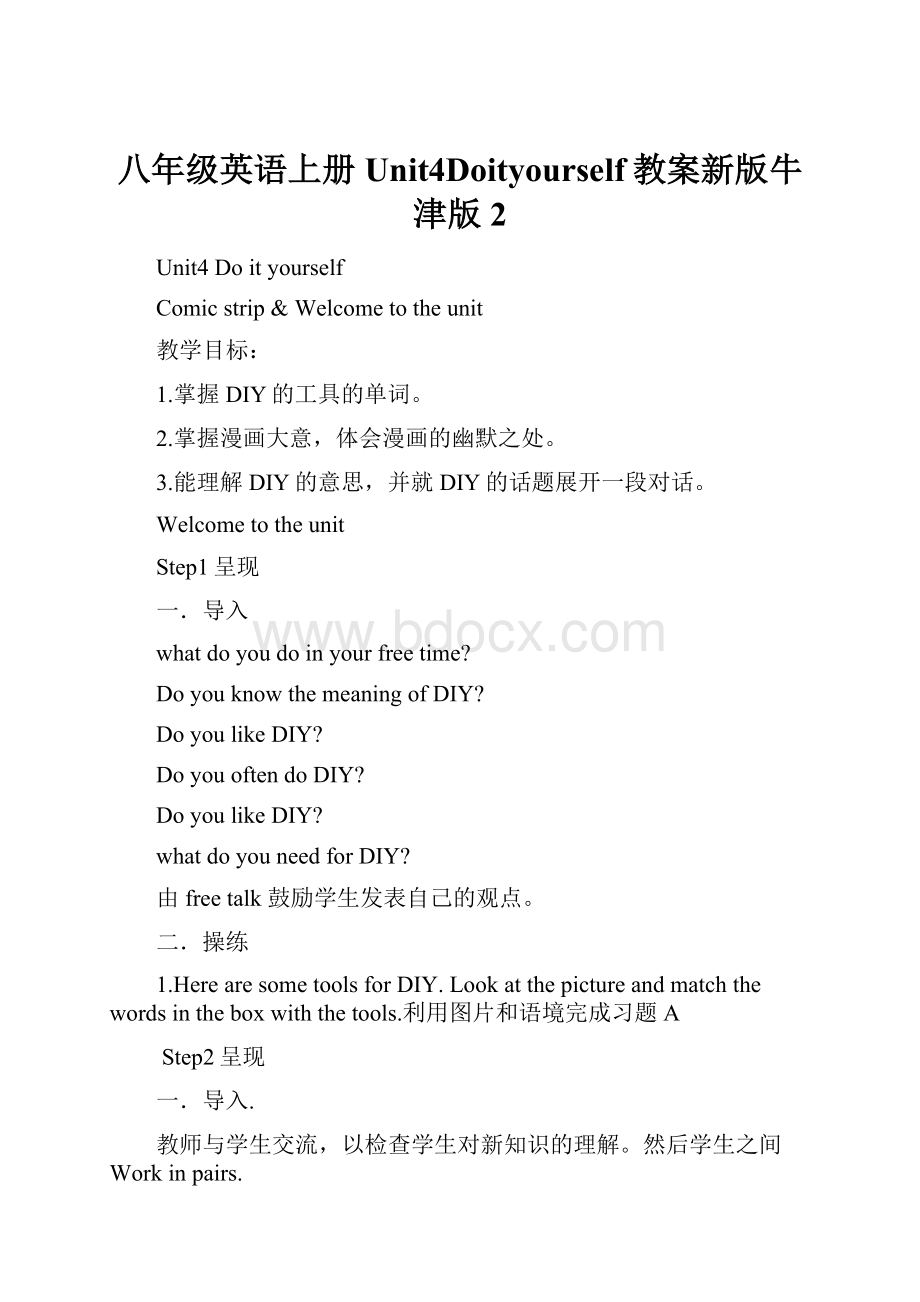八年级英语上册Unit4Doityourself教案新版牛津版 2.docx
《八年级英语上册Unit4Doityourself教案新版牛津版 2.docx》由会员分享,可在线阅读,更多相关《八年级英语上册Unit4Doityourself教案新版牛津版 2.docx(16页珍藏版)》请在冰豆网上搜索。

八年级英语上册Unit4Doityourself教案新版牛津版2
Unit4Doityourself
Comicstrip&Welcometotheunit
教学目标:
1.掌握DIY的工具的单词。
2.掌握漫画大意,体会漫画的幽默之处。
3.能理解DIY的意思,并就DIY的话题展开一段对话。
Welcometotheunit
Step1呈现
一.导入
whatdoyoudoinyourfreetime?
DoyouknowthemeaningofDIY?
DoyoulikeDIY?
DoyouoftendoDIY?
DoyoulikeDIY?
whatdoyouneedforDIY?
由freetalk鼓励学生发表自己的观点。
二.操练
1.HerearesometoolsforDIY.Lookatthepictureandmatchthewordsintheboxwiththetools.利用图片和语境完成习题A
Step2呈现
一.导入.
教师与学生交流,以检查学生对新知识的理解。
然后学生之间Workinpairs.
T:
What'sDIYexactly?
S:
T:
Whatareyougoingtodothen?
S:
T:
Whatdoyouneedforthat?
S:
T:
DoyoulikeDIY?
S:
T:
That’sfun.
二..操练
师生对话演示,生生对话操练。
从实际运用中掌握对话。
Comicstrip
Step1呈现
一.导入.
放录音,看图片,理解对话内容。
回答下列问题:
Whatdotheybuy?
Whatshouldtheydonext?
DoEddieaspossible.
A.goB.togoC.goesD.going
2.---MyEnglishisverypoor.Canyouto.C.insteadofD.lookafter.
5.Danny,comeaboutAndrewandtheSs’abilityoflearningbydoing
3、情感目标:
Totrainthestudentsdoinyourfreetime?
GuesswhatIoftendoinmyfreetime?
DoyouknowDIY?
DoyoulikeDIY?
Giveussomeexamples.
Step2Presentation
出示Andrew手拿DIY工具的图片呈现课题MycousinandDIY.
快速阅读文章,回答:
What’sthearticlemainlyabout?
分析文章结构,归纳大意:
Part1:
(para1)IntroductionofAndrew
Part2(para2---4)Andrew’sDIYjobs
Part3:
(para5)AdvicefromSuzy
4.仔细阅读文章,划出生词、难以理解的短语和句子。
(教师巡视课堂,把部分生词、短语板书在黑板上)
decorateputinabrighterlightDIYattendlessonsinstead
通过生生之间、师生之间的互动解决难题。
Step3Practice
听录音,判断正误,给出正确答案。
Wh-questions.
3.大声朗读文章。
Step4Activity
仔细阅读文章的主体Andrew’sDIYjobs,完成下面的表格:
WhatAndrewdid
Problems
Step5Retell
根据关键词复述文章。
Step6Discussion
WhatdoyouthinkofAndrew?
WhatshouldwedowhenwedoDIYjobs?
Step7Homework
复述或背诵课文。
写一个自己的DIY故事,下节课大家分享。
板书设计:
________________________________________________________________________________________________________________________________________________________________________________________________________________________________________________________________________________________________________________________________________________________________________________________________________________________________________________________________________________________________________________________________________________________________________________________________________________________
教后记:
____________________________________________________________________________________________________________________________________________________________________________________________________________________________________________________________________________________________________________________________________________________________________________________________________________________________________________________________________________________________________________________________________________________________________________________________________________________
8AUnit4Reading
(2)
1、知识目标:
(1)、会用本课时的四会单词。
(2)、Toanalyzethephrase,sentencesforthestudentstogetabetterunderstanding.
(3)、TogetmoredetailedinformationaboutAndrewandtheSs’abilityoflearningbydoing
3、情感目标:
Totrainthestudents。
YesterdaywelearntthestoryofAndrewandyousaysomethingaboutAndrew?
(小组展示)
Step2.Presentation
A.Reading:
LettheSsreadthecontextcarefullyandthenanswertheQS.
Qs:
1.)WhatisAndrewcrazyabout?
2.)Whatdoesthewall?
5.)IfyouwereAndrew,discussabrighterlight
2.thewall
5.doingsth.
8.notonly...butalso...
9.putuptheshelf
10.advisesb.todo
11.takeacourseinDIY
12.makeaskthemtodiscusstheminpairsandtrytoworkoutthemeaningsfromthecontext.Atlasttheteachertriestothelanguagepoints.
fill…with用…填满…
Eg:
Ifilledthepillowwithcotton.
Tokeepfish,weshould_thetank_waterfirst.
2、notonly…butalso…
Eg:
1)ThelivingroomnotonlybutalsoMisszhoulikesDIY
4)NotonlyMissLinbutalsosomestudentslikeDIY
=Notonlysomestudentsbut
alsoMissLinlikesDIY.
Workoutrules:
当notonly…butalso…用于行为动词时,动词相同,通常省略第二个动词。
be动词通常在notonly…butalso…之前
3)当notonly…butalso…l连接主语时,动词使用就近原则
3、instead,insteadof
Eg:
Andrewisstubborn.Hedidn'ttakeSuzy'sadvice.
Instead,SuzyislearningaboutDIY.
=,_.
2)Hewantssomemilk_Coke.
3)Hewilllistentotheradio_watchingTV.
Workouttherule:
Instead常用于句首或句末,insteadof后跟名词或动名词。
Step3.practice
Getthestudentstoreadthepassagetogetheraloudagain,
1)NowyouknowAndrewandyouretellthetext?
2)CompletetheconversationonPage46B4.
3)HereisaDIYadvertisements,canyoufinishit?
Wantto(安装电灯).(putinalight)
Wantto(修理坏掉的水管).(repairthebrokenpipe)
Don'tknowDIY.(advise,takeacourse)
Youcan(上课)everyweekend.(attendlessons)
Step4.Activities
EnjoyDIY:
AskSstoworkingroups,accordingtotheteacher'sinstructionstodotheirDIYjobs
A:
Havingadiscussioningroups
Group1:
makingalovelyenvelope
Group2:
makingabirthdaycard
Group3:
paintingthepaper
B:
Grouppresentation
Step5、Havingatest
“自主检测”部分
Homework
1、Torecitethetext.
2、Writeapassageabout
1.Playagame
学生根据听到的指令,做相应的动作。
E.g.Pleaseplease!
Openthedoor!
Pleasedon’tclosethewindow!
………
Step3Presentation
1.学生观察黑板上呈现的句子和普通的句子有何不同。
(讨论)
板书:
Putupapictureonthewall.
Don’tstandonthedesk.
Pleasepassthebooktome.
2.学生讨论回答祈使句与普通句子的区别。
3.学生总结祈使句的概念和句型结构
概念:
祈使句是用来发出命令或指示,提出要求或建议的句子。
主语为第二人称you,通常不表示出来,而是以动词原形为开头。
结构:
肯定祈使句以动词原形开头
Putupapictureonthewall.
否定祈使句以Don’t开头
Don’tstandonthedesk.
Please可以加在这两种句型的前后,表示更有礼貌。
Pleasepassthebooktome.
Step4Practice
1.学生完成书本P47的练习
Howtomakecards
学生完成练习的校对。
学生朗读练习中的5个句子。
4.多媒体呈现多个图片,学生根据图片说出相应的祈使句。
Step5Exercise
将下列句子改成肯定或否定祈使句
Come’tclimbthetree.
Readthebookcarefully.
Don’twaitfor
Freetalk
DoyoulikeDIY?
Whatkindofthingsdoyouliketodobyyourself?
(Ilikedoingsomethingdeliciousinthekitchen)
Canyougiveussomeexamples?
E.g.Becarefulwithfire.
Youshouldbecarefulwithfire.
2.presentthesentences
Cookingisdifficult.
Therearemanybooksaboutcooking.
Fireandknivescanbedangerous.
Sometimeswewillspentalotoftimeonthefood.
Adviceisimportant.
Youshouldreadbooksaboutcooking.
Cookingisdifficult.Youshouldjoinaclubtolearnmoteaboutit.
Fireandknivescanbedangerous.Youthefood.Youshouldbepatient.
Adviceisimportant.youtoyourteacherormotherreadsometolearnmoreaboutit.
StepThreePractice
PartB
Completethesentences.
Moreexercises
Checkouttheanswers
(在讲解的过程中适当的扩展点内容。
oughttomust...)
板书设计:
________________________________________________________________________________________________________________________________________________________________________________________________________________________________________________________________________________________________________________________________________________________________________________________________________________________________________________________________________________________________________________________________________________________________________________________________________________________
教后记:
________________________________________________________________________________________________________________________________________________________________________________________________________________________________________________________________________________________________________________________________________________________________________________________________________________________________________________________________________________________________________________________________________________________________________________________________________________________
8Aunit4Intergratedskills
Step1导入话题
DoyoulikeDIY?
Whatdoyouliketomakebyyourself?
Canyoumakeafruitsalad?
Whatdoweneedtomakeafruitsalad?
Step2单词教学
投影仪、图片呈现单词
看音标,学生尝试阅读单词,教师适时指导纠正并带读。
Step3呈现A1
Listenandtickthethingstheyneed.
Checkout
Step4呈现A2
1.Howtomakeafruitsalad?
小组讨论制作步骤。
2呈现A2句型,小组合作阅读、翻译句型并排序(教师巡视,适时帮助指导)
小组展示答案,教师鼓励。
集体阅读句型。
Step5呈现A3
1.小组讨论制作沙拉的注意点。
2.小组合作阅读A3短文,猜测答案。
3.听录音,完成短文。
4.集体核对答案。
5.小组合作阅读A3短文,互相帮助,解决疑难。
6.教师帮助学生解决难点,如:
inseason的含义
Step6呈现Speakup
导入
Whatdoyouoftenandanswerquestions.
呈现问题,播放录音。
Aresandwichesquickandeasytomake?
Whatdotheyputonthebread?
Dotheyjustneedonepieceofbread?
跟读对话。
分角色朗读对话。
Actout
全班一起讨论制作面条的步骤,教师给出步骤提示。
小组合作,以Howtocooknoodles为话题改编对话,并展示。
板书设计:
_______________________________________________________________________________________________________________________________________________________________________________________________________________________________________________________________________________________________________________________________________________________________________________________________________________________________________________________________________________________________________________________________________________________________________________________________________________________
教后记:
_________________________________________________________________________________________________________________________________________________________________________________________________________________________________________________________________________________________________________________________________________________________________________________________________________________________________________________________